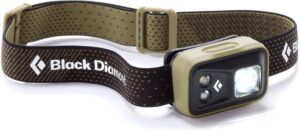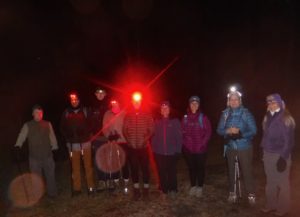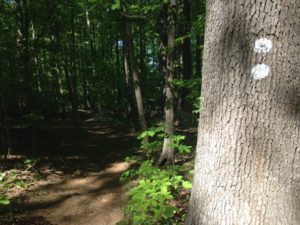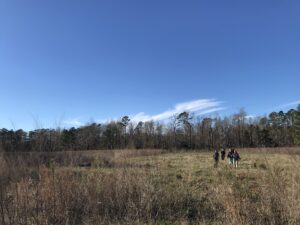Editor’s note: Every year at this time, upon the dawn of Daylight Saving Time (it’s this Sunday, btw; remember to Spring forward), we celebrate the return of afterwork light with a tabulation of tips on how to celebrate this late-day sunlight. Most of these we’ve run before, a few are new. All, hopefully, will help you rev up your outdoor experiences.
For much of the winter, the sun set long before we had a chance to enjoy it after getting off work. Now, it stays out later and later, and so do we. Sometimes later than we anticipated.
When we become drunk on sunlight and it leaves the party before we were expecting, it’s good to know a thing or two about navigating in the dark, and near dark. Today, we share some tips based on our experience of leading night hikes for the past 10 years.
Before heading out
 Pack a headlamp. This is a must. Flashlights, work, but you want to keep your hands free. You can get a decent headlamp for as little as $15; note that LEDs cast a more hike-friendly light.
Pack a headlamp. This is a must. Flashlights, work, but you want to keep your hands free. You can get a decent headlamp for as little as $15; note that LEDs cast a more hike-friendly light.- Pack extra batteries and a spare light. Batteries can fizzle without warning and a spare light is a must (if for no other reason than to help you see to change batteries in your primary torch).
- Pick short hikes to start. Hiking in the dark takes some getting used to. Your world is confined to the glow of your headlamp, and it takes some concentration to focus on a limited portion of trail. It can be a sensory overload, as your other senses tune in to the world beyond the scope of your light, so don’t overstay on your first outing.
- Hike trails you’ve hiked in daylight. Even though it’s dark, familiarity is a huge plus. You’ll be amazed at how things you didn’t think you noticed during the day will pop out as key markers of where you are on the trail.
- Take a map and compass. You should already have these in your daypack as part of your 10 Essentials, but make extra sure you have them at night. If you become … misplaced, finding a point of reference that matches with your map will go a long way toward getting you back to your car.
- Take water and snacks. Just because it’s dark and likely cool doesn’t mean you can’t get dehydrated. And hiking in the cool air will burn some calories; you’ll be glad to have the extra fuel.
- Be aware of posted hours. Trails on certain public lands are closed from dusk until dawn. That includes state parks and nearly all municipal and county trails. National forests typically don’t have hours, nor do lands managed by the N.C. Wildlife Resources Commission.
- That said, March and the advent of Daylight Saving Time is when many parks begin staying open later. Eno River State Park’s main access, Fews Ford, which had been closing at 7 p.m. now closes at 9 p.m. Check hours before heading out.
- And that said, just because a park is open late doesn’t affect actual sunset. While the Fews Ford Access above may now be open until 9 p.m., the sun today still sets at 6:17 p.m., nearly three hours before official sunset.
- That said, March and the advent of Daylight Saving Time is when many parks begin staying open later. Eno River State Park’s main access, Fews Ford, which had been closing at 7 p.m. now closes at 9 p.m. Check hours before heading out.
At the trailhead
 Bundle up. Nighttime is cooler than day, of course. Counter the chill with one more layer than you think you’ll need; you can always shed a layer later.
Bundle up. Nighttime is cooler than day, of course. Counter the chill with one more layer than you think you’ll need; you can always shed a layer later.- Don’t hike alone. I do a lot of soloing, but not at night. Make sure you have a buddy with you.
- Take your phone. Another way to figure out where you are: call up your favorite map program, even one that focuses on roads. It may not show the trail you’re supposed to be on, but it will show the nearest road: Keep your blue dot headed toward it (which might require some timber-bashing).
On the trail
 Be vigilant about blazes. If you don’t see a blaze ahead of you, turn and check to see if you can spot one from the direction you came. .
Be vigilant about blazes. If you don’t see a blaze ahead of you, turn and check to see if you can spot one from the direction you came. .- Hike by your feet. It takes a bit more effort to scout out the blazes at night. The best way to tell whether you’ve wandered off the beaten path is if your boots suddenly sink into soft, untrod leaf litter. Backtrack and seek out the firm footing of the trail.
- Stop, look, listen. Night hiking is a much different experience. Take the time to savor it.
- Appreciate the night sky. Because that’s one of the reasons you’re out there!
- Beware the gloaming. There’s a roughly 10-minute period before the end of twilight when there’s not enough light to see on your own, yet your headlamp is no help, either. This is a good time to stop, look and listen.
- Resist the urge to turn on your lamp prematurely. Especially if you are in a group, because once you light up, your light will cast shadows making it hard for the unlit to see.
- Stay within earshot of fellow hikers. It’s much easier to lose people in your group at night; make sure you can at least hear their footsteps.
Daylight Saving Time is nigh. Now’s the time to make the most of midweek adventure.
* * *
Weekend Escape in the Croatan
 Looking to come out of hibernation? We’ve got just the trip the weekend of March 15-16 with two hikes in the coastal Croatan National Forest.
Looking to come out of hibernation? We’ve got just the trip the weekend of March 15-16 with two hikes in the coastal Croatan National Forest.
- Friday evening. We start with a Friday evening sunset hike on the 1.6-mile Cedar Point Tideland Trail, which takes advantage of multiple boardwalk stretches to navigate a tidal wetland. An awesome spot to catch the sunset.
- Saturday, it’s our favorite hike at the coast, the 11-mile Weetock Trail. The first 6 miles of the Weetock is a rolling hike on easy-to-follow blazed trail through scenic coastal woods. The last 5 miles is a wild romp through coastal forest that will test your navigational skills.
It’s the ideal time to hike at the coast, before it warms up and brings out the bugs, and a great way to kick off your 2024 hiking season. Learn more and sign up here.
